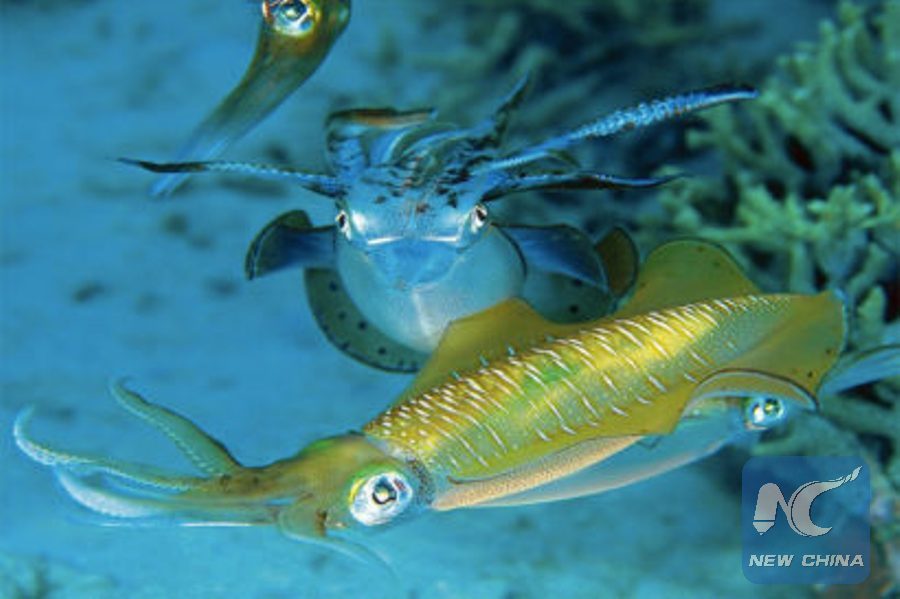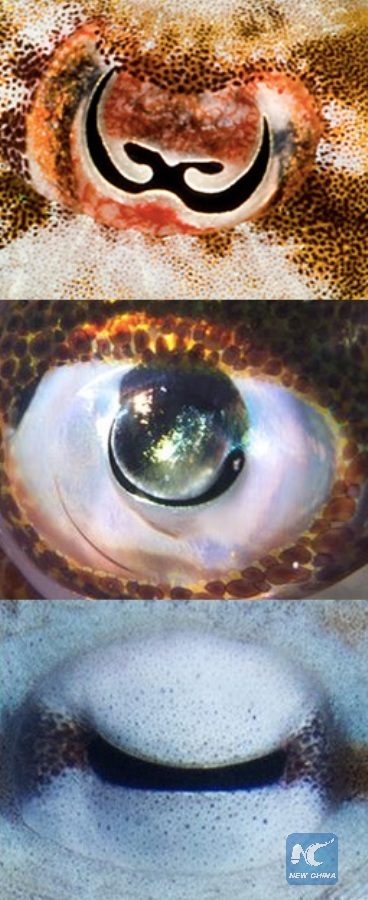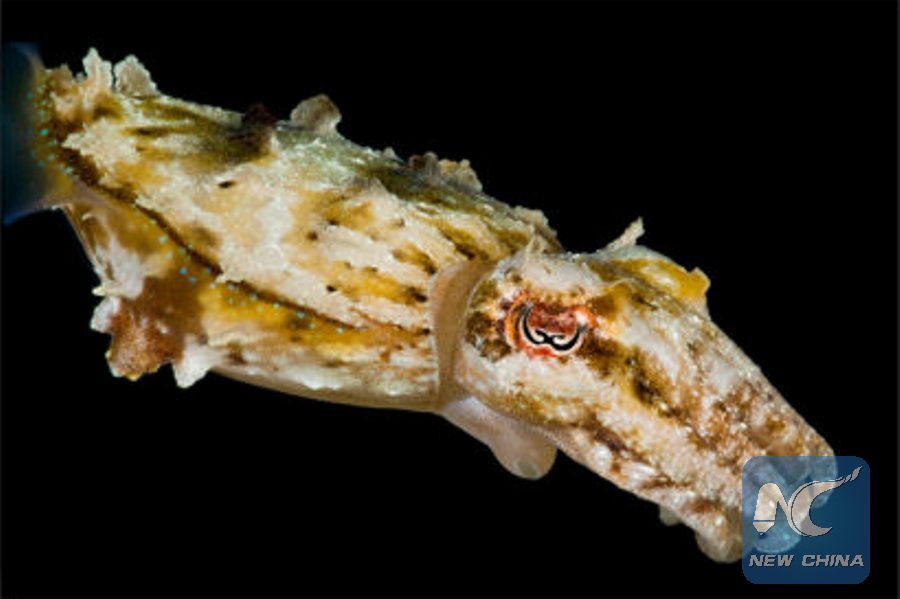
The big-fin reef squid Sepioteuthis lessoniana changes color while signaling to members of its own species.(courtesy of UC Berkeley)
SAN FRANCISCO, July 17 (Xinhua) -- U.S. researchers have found that while octopuses, squid and other cephalopods are colorblind, their weirdly shaped pupils may allow them to detect color and mimic the colors of their background.
The researchers, a father/son team from the University of California, Berkeley, and Harvard University, believe that the key for cephalopods to be able to see color, just differently from any other animal, is an unusual pupil that allows light to enter the eye through the lens from many directions, rather than just straight into the retina.

The weird pupils of cephalopods (from the top, a cuttlefish, squid and octopus) allow light into the eye from many directions, which spreads out the colors and allows the creatures to determine color, even though they are colorblind. (courtesy of UC Berkeley)
The U-shaped, W-shaped or dumbbell-shaped pupil accentuates the chromatic aberration, and may enable cephalopods to judge color by bringing specific wavelengths to a focus on the retina, much the way animals like chameleons judge distance by using relative focus, said UC Berkeley graduate student Alexander Stubbs. They focus these wavelengths by changing the depth of their eyeball, altering the distance between the lens and the retina, and moving the pupil around to change its off-axis location and thus the amount of chromatic blur.
"We propose that these creatures might exploit a ubiquitous source of image degradation in animal eyes, turning a bug into a feature," Stubbs was quoted as saying by a UC Berkeley news release. "While most organisms evolve ways to minimize this effect, the U-shaped pupils of octopus and their squid and cuttlefish relatives actually maximize this imperfection in their visual system while minimizing other sources of image error, blurring their view of the world but in a color-dependent way and opening the possibility for them to obtain color information."
Alexander Stubbs teamed up with his father, Harvard astrophysicist Christopher Stubbs, to develop a computer simulation to model how cephalopod eyes might use this to sense color and published their hypothesis online in the journal Proceedings of the National Academy of Sciences.
The two researchers concluded that a U-shaped pupil like that of squid and cuttlefish would allow the animals to determine the color based on whether or not it was focused on its retina. The dumbbell-shaped pupils of many octopuses work similarly, since they are wrapped around the eyeball in a U shape and produce a similar effect when looking down.

The pupil of the cuttlefish Sepia bandensis is believed to maximize chromatic blur, allowing the animal to detect color. (courtesy of UC Berkeley)
"Their vision is blurry, but the blurriness depends on the color," Stubbs said. "They would be comparatively bad at resolving white objects, which reflect all wavelengths of light. But they could fairly precisely focus on objects that are purer colors, like yellow or blue, which are common on coral reefs and rocks and algae. It seems they pay a steep price for their pupil shape but may be willing to live with reduced visual acuity to maintain chromatically-dependent blurring, and this might allow color vision in these organisms."
"We carried out extensive computer modeling of the optical system of these animals, and were surprised at how strongly image contrast depends on color," said Harvard's Stubbs. "It would be a shame if nature didn't take advantage of this."
Human and other mammalian eyes have round pupils that contract to pinholes to give us sharp vision, with all colors focused on the same spot. But as anyone who's been to the eye doctor knows, dilated pupils not only make everything blurry, but create colorful fringes around objects, what is known as chromatic aberration. This is because the transparent lens of the eye, which in humans changes shape to focus light on the retina, acts like a prism and splits white light into its component colors. The larger the pupillary area through which light enters, the more the colors are spread out. The smaller our pupil, the less the chromatic aberration.
"We believe we have found an elegant mechanism that could allow these cephalopods to determine the color of their surroundings, despite having a single visual pigment in their retina," said the younger Stubbs. "This is an entirely different scheme than the multi-color visual pigments that are common in humans and many other animals. We hope this study will spur additional behavioral experiments by the cephalopod community."

